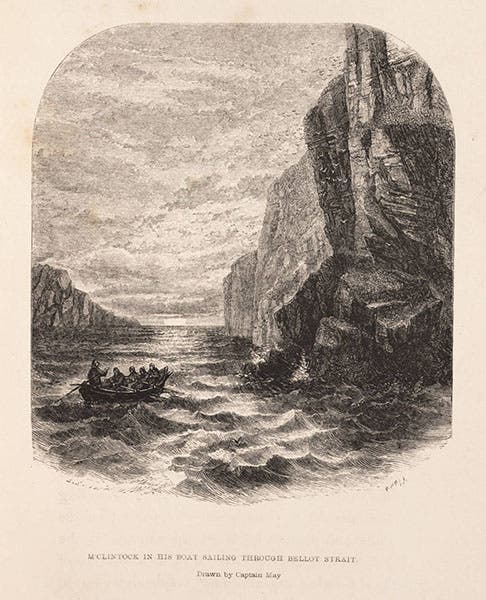Scientist of the Day - Joseph René Bellot
Joseph René Bellot, a French naval officer, was born Mar. 18, 1826. Bellot was an up-and-coming young lieutenant when he was asked in 1851 by Lady Jane Franklin to join a privately-funded search for her husband, Sir John Franklin, his two ships, and his crew of 130 men, all of whom had been missing somewhere in the Arctic archipelago since 1847. The voyage was led by the Canadian William Kennedy in a private ketch, the Prince Albert.
Kennedy and Bellot did not find Franklin, but they did explore much of the shoreline of North Somerset and Prince of Wales Land (see map, third image). Most of their exploration was by sledge, including one 95-day journey, covering over 1200 miles of uncharted territory, that rivals the more famous sledge expedition of Francis McClintock the year before. They also discovered the strait that separates North Somerset from the Boothia Peninsula, now known as Bellot Strait. The Kennedy-Bellot voyage is famous for being the first to adopt native Inuit lifestyles, including building and living in snow igloos (second image). We featured the Kennedy-Bellot expedition in our 2008 exhibition, Ice: a Victorian Romance. McClintock later sailed through the Bellot strait on his search for Franklin in the Fox and recorded the transit with an image in his narrative (fourth image).

Map of the part of the Arctic archipelago explored by Bellot and Kennedy; Bellot strait is near the bottom, across the narrow waist of North Somerset; Wellington Channel, where Bellot died, is at upper right center; from William Kennedy, A Short Narrative of the Second Voyage of the Prince Albert, 1853 (Linda Hall Library)
A year later, Bellot returned to the Arctic on the Phoenix, a supply vessel supporting the 5-ship Arctic Squadron led by Edward Belcher. While making a trek on an ice floe in Wellington Channel, on Aug. 18, 1853, Bellot disappeared through the ice. His body was never recovered. He was 27 years old. His sacrifice gained him immediate renown back in England.
A memorial to Bellot was put in place on Beechey Island in 1854 and pictured in Belcher’s narrative about his Arctic Squadron; it was sponsored by John Barrow of the Admiralty, son of the more famous Sir John Barrow who started the whole Arctic exploration business back in 1818 (fifth image).
Since very few people in England or France were likely to ever see Beechey Island, another memorial, this one a large obelisk designed by Philip Hartwick, was erected near Greenwich Hospital on the Thames in 1856, and recorded in a painting the next year by George Chambers, Jr. (sixth image). It still stands. We also include here a detail of the plaque on the Thames memorial (seventh image).
There is a portrait of Bellot, by the Victorian artist Stephen Pearce, in the National Portrait Gallery in London. For some reason, we prefer the mezzotint made after that portrait, also in the NPG (first image).
Dr. William B. Ashworth, Jr., Consultant for the History of Science, Linda Hall Library and Associate Professor emeritus, Department of History, University of Missouri-Kansas City. Comments or corrections are welcome; please direct to ashworthw@umkc.edu.











